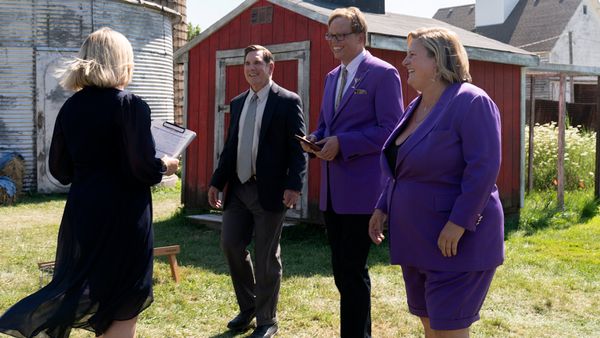
October 14, 2017
Out There :: Music for the Curious at Heart
Roberto Friedman READ TIME: 4 MIN.
What the Davies Hall nightclub SoundBox is to the San Francisco Symphony, SF Opera Lab Pop-Ups are to the San Francisco Opera - "entry points" for the "opera-curious" to explore the mysteries and power of the human voice, theatrically, in intimate spaces well beyond the War Memorial Opera House. Since the first event at Public Works in 2016, Pop-Ups have been held at the Chapel and Oasis in SF, and at the Uptown in Oakland.
Tonight (Thurs., Oct. 12), Opera Lab pops up at the dance club Mezzanine in downtown SF. The event, dubbed "Operatronica," features operatic arias performed by Adler Fellows and electronic dance music (EDM) by the DJs of SF-based Loves Company. This genre-blending evening might seem like an unusual musical mixture, but it comes from the imagination of its co-host, Verdian bass Anthony Reed, who is comfortable in the worlds of both opera and EDM. In his third year as an Adler Fellow, Reed also co-leads and records with an electronica group. He has been seen on the Opera House stage this season in Strauss' "Elektra" and Verdi's "La Traviata."
Songs from the operatic repertoire will alternate with EDM sequences. Along with bass Reed, director Aria Umezawa, a first-year Adler Fellow, will curate and host the evening. Adler Fellows who will perform include sopranos Toni Marie Palmertree, Sarah Cambidge and Amina Edris; tenors Pene Pati, Amitai Pati and Kyle van Schoonhoven; baritone Andrew G. Manea; bass-baritone Brad Walker; co-host and bass Reed; and pianists Jennifer Szeto and Ronny Michael Greenberg.
Here's the deets in a nutshell: "Operatronica," SF Opera Lab Pop-Up at Mezzanine, 444 Jessie St., SF. Thurs., Oct. 12, doors at 8 p.m., show at 9 p.m. Tickets: ($20 advance, $25 at the door, $40 VIP) visit sfoperalab.com.
Planet Rock
We've been listening to the new collaborative album "Planetarium" (4AD), and it's sent us way out of this world. The music is a stellar combination of vocals by Sufjan Stevens, Bryce Dessner on guitar, compositions by Nico Muhly and beats by James McAlister. The tracks pay tribute to the planets and a few other celestial bodies. In album order, if not exactly that of an orrery (a model of the solar system), the subjects are Neptune, Jupiter, Hailey's Comet, Venus, Uranus (no jokes, please), Mars, Black Energy, Sun, Tides, Moon, Pluto, Kuiper Belt, Black Hole, Saturn, In the Beginning, Earth and Mercury.
If you know Stevens' angelic voice, you recognize it at first wail. It's all the more ethereal as it emanates from a body that exhibits so many masculine signifiers. Muhly's compositional know-how manifests itself in the sophisticated orchestrations of the album's piano ballads and spacey electronics. Percussive rhythms never let us lose the beat. Stevens' vocals explore mythology, astrology, science, astronomy and the mysteries of human consciousness. Are the songs about the planets, or are they allusions to the Roman and Greek gods they were named for? We dunno, but we enjoy the teasing ambiguity. Hello, Spacemen!
Purr-fect Pianism
Concert pianist Jeremy Denk, who recently appeared with the San Francisco Symphony under Michael Tilson Thomas to tackle Bartok's Piano Concerto No. 2, is also a formidable intellect and blogger ("Think Denk"). In a fascinating piece for The New York Times earlier this year, he made the case for Frederic Chopin as the most catlike of Romantic composers.
Denk asserts that Chopin's genius depended upon "a catlike understanding of which notes hold on and which let go," "suspending dangerously on a single note or pair of notes, and then, once a foothold is established, leaping to a new harmony as if it were nothing" - as a cat will leap from, say, kitchen counter to floor.
Of the composer's characteristic bass notes, Denk writes, "The foundation, the deepest note, is felt as light, pillowy: a perfect analogue to cat's paws, the sense of grace and lift from below." The paw that refreshes.
His essay goes on to compare Chopin's "catlike subtlety" to the bombastic virtuosity of another 19th-century pianist-composer, Franz Liszt, who "had many virtues but was almost never as subtle or tasteful as Chopin: He was an enthusiastic, friendly dog, often too eager to please." Lots to chew on for lovers of cats and classical music, this kind of intellectual conjecture is catnip to the likes of Out There.
Poster Boards
San Francisco Art Exchange (SFAE) is currently showing original artworks used to create the film posters for Hollywood films released between the 1960-90s. They include the painting used for the production of the movie poster for "My Fair Lady" in 1964, starring Audrey Hepburn & Rex Harrison. Also on offer are the original paintings used for the posters for Academy Award-winning films "Camelot" (Richard Harris & Vanessa Redgrave), "Cool Hand Luke" (Paul Newman), "The Life and Times of Judge Roy Bean" (Newman), "Mame" (Lucille Ball), "McCabe and Mrs. Miller" (Warren Beatty & Julie Christie), "Deliverance" (Burt Reynolds, Jon Voight), and "Night Moves" (Gene Hackman).
Film posters themselves have a collector's market, but the original paintings and illustrations used to create the posters are rarely offered for sale. Interested collectors should contact [email protected] to receive a full prospectus with pricing.







